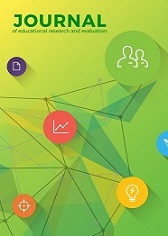Developing Tri Kaya Parishida Based Blended Learning Media Using Adobe Captive for Probstat Courses
DOI:
https://doi.org/10.23887/jere.v3i3.21858Keywords:
R & D, TK based BLM, ProbstatAbstract
The objectives of this study ware to: (1) Design TKP based BLM that was based on the needs of students and lecturers for probability and statistics courses at the Informatics Management Department of Politeknik Ganesha Guru; (2) Measure the quality of TKM based BLM that was based on the needs of students and lecturers for probability and statistics courses in the Informatics Management Department of Politeknik Ganesha Guru; (3) Determine student and lecturer responses to the implementation of the TKM based BLM that was based on the needs of students and lecturers for probability and statistics courses in the Informatics Management Department of Politeknik Ganesha Guru; (4) Determine student learning outcomes before and after the implementation of the TKP based BLM in the teaching and learning process. The research conducted at the Politeknik Ganesha Guru. The subjects of the study were students and lecturers at the Politeknik Ganesha Guru who volunteered in the product trials and run trials in this study. The object of this research was the TKM based BLM developed for the Probstat course. The type of research chosen was Research and Development (R&D). Based on the Result and Discussion, it could be concluded that: (1) the TKM based BLM product was developed based on the needs of students and lecturers for probability and statistical courses through the R&D method; (2) the quality of BLM based TKP products scored 91.33, qualified as very good, provided by the content experts and media experts rated the product 91.67 qualified it as very good; (3) students and lecturers responses to the implementation of the TKM based BLM were given an average score of 97.92 qualified as very good; (4) there is a significant difference between the pretest and posttest trials using the TKM based BLM (sig. 0,000 <0.005), an increase in the value of the pretest value 33.74 to 73.6 posttest.
References
Adnyana, P.B. & D.M. Citrawathi. (2017). “Model Pendidikan Karakter Berbasis Tri Kaya Parisudha Terintegrasi Dalam Pembelajaran Di Sekolah Dasar”. Seminar Nasional Riset Inovatif: 862-868, eproceeding.undiksha.ac.id/index.php/senari/article/download/1054/780 diakses 16 Agustus 2018
Artini, Ni Luh Pt. 2016. “Pengaruh Model Pembelajaran Kooperatif TipeThink -Talk- write Berbasis Kearifan Lokal Tri Kaya Parisuda”. E-Journal MIMBAR PGSD Universitas Pendidikan Ganesha, Volume 6 Tahun 2016. Tersedia pada http://ejournal.undiksha.ac.id/index .php/JJPGSD/article/view/8623 (diakses pada tanggal 12 mei 2017)
Cheung, W. S., & Hew, K. F. (2011). “Design and Evaluation of Two Blended Learning Approaches: Lesson Learned”. Australasian Journal of Educational Technology 27 (Special issue, 8) , 1319-1337.
Danim, Sudarwan. (2010). Pengantar Kependidikan. Bandung : Alfabeta
DEECD. (2012). Blended learning,A Synthesis Of Research Findings in Victorian education 2006-2011. Melbourne: the Ultranet and Digital Learning Branch Department of Education and Early Childhood Development Melbourne.
Emzir. (2015). Metodologi Penelitian Pendidikan. Jakarta: PT. RajaGrafindo Persada
Fujiyanto A., Asep K.J., & Dadang K. 2016. Penggunaan Media Audio Visual Untuk Meningkatkan Hasil Belajar Siswa Pada Materi Hubungan Antarmakhluk Hidup. Jurnal Pena Ilmiah Vol. 1 No. 1: 841-850
Irmayanti, K.M., Parmiti, D.P., dan Sudana, D.N.. (2017). “Pengaruh Model Pembelajaran Group Investigation Berbasis Kearifan Lokaltri Kaya Parisudha Terhadap Hasil Belajar IPS”. e-Journal PGSD Universitas Pendidikan Ganesha Mimbar PGSD Vol.5 No. 2: 1-10
Kuniawati, I.D., & Nita S. 2018. Media pembelajaran berbasis multimedia interaktif untuk meningkatkan Pemahaman konsep mahasiswa. Journal of Computer and Information Technology Vol. 1 No. 2: 68-75
Obiedat, R, Nasir E. L., O. Harfoushi, A. Koury, M. AL-Hamarsheh, and N. AlAssaf. (2014). “Effect of Blended-Learning on Academic Achievement of Students in the University of Jordan”. iJET Vol. 9, I. 2: 37-44
Sanjaya, Wina (2014). Media Komunikasi Pembelajaran, Jakarta: Kencana Prenada Media Group
Sanaky, Hujair AH. (2011). Media Pembelajaran. Bantul: Kaukaba Dipantara.
Sharma, P., & Barrett, B. (2011). Blended Learning: Using Technology in and Beyond the Language Classroom. Oxford: Macmillan
Siegel, K. 2015. Adobe Captivate 9: The Essentials “Skills and Drills” Learning. US: IconLogic Inc.
Sugiono. (2013). Metode Penelitian Kombinasi. Bandung: Penerbit Alfabeta
Suhardana, K.M. (2007). Tri Kaya Parisudha: Bahan Kajian untuk Berpikir Baik, Berkata Baik, dan Berbuat Baik. Surabaya: Paramita
Syam, N. (2012). Peranan Software Adobe Captivate Untuk Meningkatkan Hasil Belajar Fisika Pada Peserta Didik Kelas VIIIA SMP Negeri 5 Pallangga Gowa. JPF Vol. 5 No.1: 43-50
Tafonao, T. 2018. Peranan Media Pembelajaran Dalam Meningkatkan Minat Belajar Mahasiswa. Jurnal Komunikasi Pendidikan, Vol.2 No.2: 103-114
Yamin, S. & Heri K. 2014. SPSS Complete: Teknik Analisis Terlengkap dengan Software SPSS. Jakarta: Penerbit Salemba Infotek
Downloads
Published
How to Cite
Issue
Section
License
Authors who publish with the Journal of Evaluation and Research in Education (JERE) agree to the following terms:
- Authors retain copyright and grant the journal the right of first publication with the work simultaneously licensed under a Creative Commons Attribution License (CC BY-SA 4.0) that allows others to share the work with an acknowledgment of the work's authorship and initial publication in this journal.
- Authors are able to enter into separate, additional contractual arrangements for the non-exclusive distribution of the journal's published version of the work (e.g., post it to an institutional repository or publish it in a book), with an acknowledgment of its initial publication in this journal.
- Authors are permitted and encouraged to post their work online (e.g., in institutional repositories or on their website) prior to and during the submission process, as it can lead to productive exchanges, as well as earlier and greater citation of published work. (See The Effect of Open Access)











